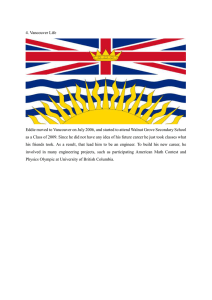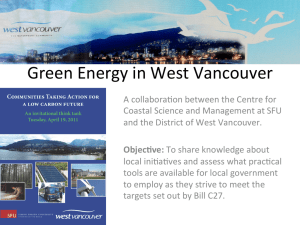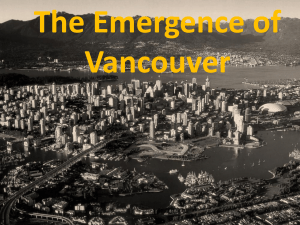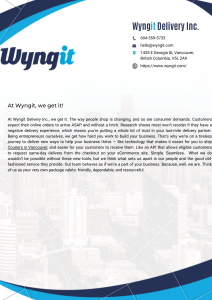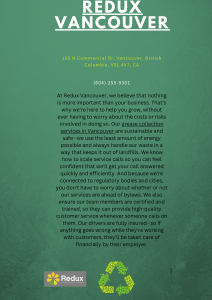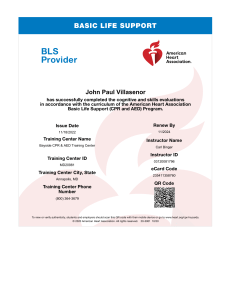CPR v. City of Vancouver: Property Regulation & Railway History
advertisement
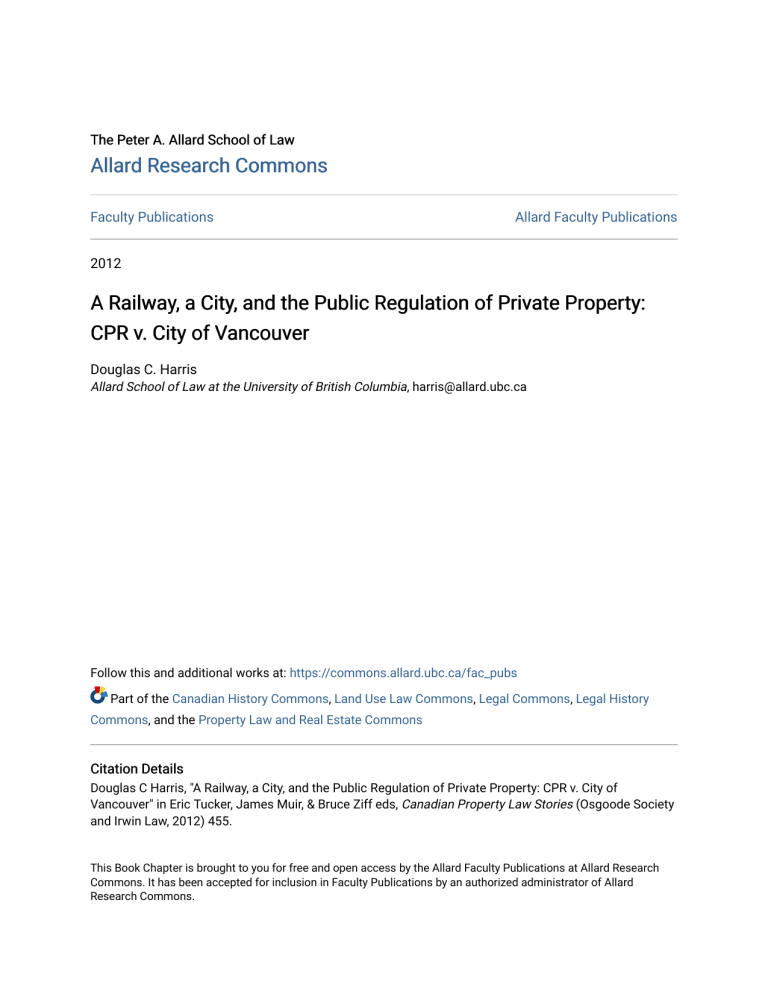
The Peter A. Allard School of Law Allard Research Commons Faculty Publications Allard Faculty Publications 2012 A Railway, a City, and the Public Regulation of Private Property: CPR v. City of Vancouver Douglas C. Harris Allard School of Law at the University of British Columbia, harris@allard.ubc.ca Follow this and additional works at: https://commons.allard.ubc.ca/fac_pubs Part of the Canadian History Commons, Land Use Law Commons, Legal Commons, Legal History Commons, and the Property Law and Real Estate Commons Citation Details Douglas C Harris, "A Railway, a City, and the Public Regulation of Private Property: CPR v. City of Vancouver" in Eric Tucker, James Muir, & Bruce Ziff eds, Canadian Property Law Stories (Osgoode Society and Irwin Law, 2012) 455. This Book Chapter is brought to you for free and open access by the Allard Faculty Publications at Allard Research Commons. It has been accepted for inclusion in Faculty Publications by an authorized administrator of Allard Research Commons. A Railway, a City, and the Public Regulation of Private Property: CPR v City of Vancouver Douglas C. Harrisū ѕђȱџяѢѡѢѠȱќџџіёќџȱѤіћёѠȱten kilometres north-south through the west ȱȱȱ¢ȱȱǯȱ ȱȱȱȱ¢ȱȱȱęȱ ¢ȱǻǼǰȱȱę¢Ȭȱȱ¡¢Ȭ¡ȱȬ ȱȱȱȱǰȱȱ ȱȂȱǰȱ¢Ȭęȱȱȱ¢ȱȱȱǰȱȱ ȱȱȱȱȬȱȱȱǻȱūǼǯȱȱȱȱ most of the corridor out of the provincial land grant that induced the company to move the terminus of its transcontinental railway from a planned location at the eastern end of Burrard Inlet to the western end — to what ȱȱǯȱȱȱūųŪŬȱȱ¢ȱȱȱȱȱ the commercial centre of Vancouver to the northern arm of the Fraser River ȱ¢ȱȱȱęȱȱ ȱȱǰȱȱȱȱȱ ȱȱȱȱūųůŮǰȱȱȱȱȱȱȱŬŪŪūǯȱ ȱ¢ȱȱȱȱȱȱȱȱǰȱȱȱȱȱ¡ȱ ȱǰȱȱ¢ȱȱȱȱȱĜȱȱȱǻ¡ȱǼǯȱ ȱȱȱȱȱȱȱment, the plan limited use of the corridor to a “public thoroughfare” for rail, ǰȱȱ¢ǰȱȱȱȱ¡ȱȱȱȱȱȱȱ¢ȱȱȱ ȃ ¢ǯȄȱȱ ȱ¡¢ȱ¡ȱȱȱȱ would not be considered. The company turned to the courts, arguing that the City had taken its property for which compensation was due, and CPR v City of Vancouver was born.Ŭ Ůůů ŮůŰȲȊȲȱǯȱ This chapter considers the intertwined histories of a railway company and a city that gave rise to CPR v City of Vancouver. It begins with the land grants that gave the CPR such a strong corporate presence in Vancouver. The company was one of the city’s principal employers and by far its larȱǰȱȱȱȱȱȱȱȱȱĴȱȱȱ land use; industrial, commercial, and residential districts all followed the Ȃȱǯȱȱȱ¢ȱ ȱȱȱȱȱȱǰȱȱ¢ȂȱĚence waned, but it retained the capacity to shape the urban form when, in ȱ¢ȱūųŰŪǰȱȱȱǰȱȱȱ¢ǰȱȱ¢ǰȱȱ real estate development. This chapter describes these initiatives, particularly those involving rail lands that were to be converted to other, usually residential, uses. It then turns to the Arbutus Corridor, to the CPR’s development ǰȱȱȱȱ¢ȂȱĜȱȱǯ ȱęȱ ȱȱȱȱȱ¢ȱȱȱȱCPR v City of VancouverȱȱȱȱȱȱȱǻǼǰȱȱȱĚȱȱ what the decision means for the city and what it reveals about the role of the courts in Canada as arbiters of the boundary between public regulation ȱ ȱ ¢ǯȱ ȱ ȱ ęȱ ȱ ȱ ¢ȱ ¢ȱ ¢ȱ ȱ ȱȱ ȱȱȱȱȱȱ¢ȱȱȱȱada, variously, as de factoȱ¡ǰȱȱǰȱȱde facto takǰȱȱǰȱȱȱȱ ȱǰȱȱȱȱȱȱ property would amount to a taking of that property that warranted comȱ¢ȱȱȱȱě¢ȱȱȱȱand prevented all reasonable uses of that interest by its owner.ŭȱȱȱȱĜȱ ȱȱȱȱȱȱȱȱȱȱ¢ȱȱ not choose between compensating the company for its loss of a property interest or rescinding the development plan. As a result, the plan and the railway remain in place; the property remains unused and undeveloped by its owner. Beyond this particular outcome, CPR v City of Vancouver appears to ęȱȱȱȱȱȱȱȱȱȱȱȱ ¢ǯȱ ǰȱȱȱȱȱȱȱȱȱȱ public compensation for regulations that limit the uses of private property,Ů and this chapter concludes by locating this judicial reticence within a legal framework that does not include constitutional guarantees of rights to private property. ȱ ¢ǰȱȱ¢ǰȱȱȱȱȱȱȱ¢ȲȊȲŮůű ȱūǯȱȱǯ CPR and the Making of Vancouver Once upon a time, a city gave itself away in order that a great railway might be induced to establish its terminus there.ů ѕђ іѡѦȱќѓȱюћѐќѢѣђџ ȱ ȱȱȱęȱ ¢ǰȱȱȱ well have been otherwise.Űȱȱ ȱȱȱȱ¢ȱȱȱȱȱ ȱȱ ȱȱȱęȱȱ ȱȱȱȱȱȱ line’s western terminus. The Federal government had announced as much ȱūŲŲūȱ ȱȱȱȱCPR Actȱȱęȱȱ¢ȱȱȱȱȱ the line.ű In anticipation of the railway’s completion and the economic activ¢ȱȱȱȱ ȱǰȱȱȱȱȱȱȱ ȱȱȱ ȱǰȱȱȱȱǰȱȱĴȱȱȱ ¢ȱ builder itself. As a result, the CPR looked elsewhere for a location where it ȱęǰȱȱȱǰȱȱȱȱ¢ȱȱȱ ¢ȱ ȱǯȱȱȱĴȱ ȱȱȱȱȱ ȱȱȱȱȱȱ ȱ ȱȱ¢ȱ¢ȱ ¢ȱ ȱ ȱȱȱ ǯȱȱȱȱȱ¡¢ȱŮŪŪȱ ȱȱȱ¢ȱūŲŲŪǰȱ ȱȱȱȱȱȱŮŲŪȬȱȱȱȱǻȱȱůŮūǼǯȱȱȱȱȱȱ ȱȱ ȱȱǰȱȱȱ ȱǰȱȱȱūŲŲůȱȱȱȱ ȱ ȱ ȱ ȱ ȱ ȱ ȱ ǻȱ ȱ ůŬŰǼȱ ȱ ¡ȱ ŮůŲȲȊȲȱǯȱ ȱŬǯȱȱȱ ǰȱūŲŲůǯȱǻDZȱȱȱȱȱȱȱǰȱȃȁȱȱ ȂDZȱȱȱȱȱǰȱūŲŲŮȮŲųȄȱǻŬŪūŪǼȱūŰŰȱȱȱűȮŭŲȱȱūŭǯǼ ȱ¡ȱȱȱȱȱ ǯȱȱ ȱǰȱȱŰǰŮůŲȱǰȱ would comprise the largest land grant to the railway company within any Canadian city.Ų ȱ ȱ ȱ ȱ ¡£ȱ ȱ ȱ ȱ ȱ ȱ ȱ ȱ ȱ City of Vancouver in the process. The city was not so much given away, as the epigram at the beginning of this section suggests, as it was created by ȱȱȱȱȱ ¢ǰȱȱȱȱȱ¡ȱȱȱȱȱ ęȱȱȱȱȱȱȱ ȱȱȱȱȱ in downtown Vancouver: ȱ ȱȱ ȱęȱ ¢ ūŲŲů In the silent solitude Of the primeval forest ȱȱȱ ȱ In the earth and commenced ȱ ¢ǰȱȱ¢ǰȱȱȱȱȱȱȱ¢ȲȊȲŮůų To measure an empty land Into the streets of ų The provincial land grant established the CPR as the central force in Vancouver’s early development. On the basis of this landed position, and wielding threats to move the terminus elsewhere, the CPR induced the ¡ȱȱ ȱȱȱūŲůǰȱūųŰǰȱȱūŲūȱȱȱȱȱȱŮŲŪȬȱ parcel on the peninsula to give the company one-third of their holdings ǻȱ ŬǼǯȱ ȱ ȱ ȱ ȱ ȱ ȱ ȱ ȱ ȱ ȱ ¢ȱ ȱȱ ȱȱȱȱȱ ȱ ȱȱȱȱȱȯȱȱůŮūǯūŪ ȱȱȱěȱ ȱȱȱȱȱȱȱȱȱǰȱȱ ȱ ȱ ȱ ȱ ȱ ȱ ȱ ¢£ȱ ȱ ȱ ȱ ȱ ȱ ǯȱ ȱ ǻȱ ¢ȱ ¢ȱ ȱ ȱ Ǽȱ ȱ ǰȱȱȱȱȱę¢ȱ¡ȱ¢ȱȱȱȱ of the Fraser River, but work associated with the railway and with the sale ȱȱȱȱ¢ȱȱȱȱ¢ǯȱȃȱ ȱȱȱǰȄȱȱȱȱǰȱȃȱȱ wholesale merchants, lumbermen or salmon canners were Vancouver’s initial city-builders.”ūū In these early years, real estate development and a range of supporting commercial activities underwrote Vancouver’s economy, not ȱ Ȭȱ ǯȱ ¢ȱ ūŲųūǰȱ ȱ ¡ȱ ¢ȱ ȱ ȱ ǰȱ ȱ ȱȱȱŮŪŪȱȱ ȱȱȱ ȱȱ¢ȱūŮǰŪŪŪǯ As Vancouver grew, its relationship with the CPR changed. The city’s ¢ȱȱȱȱ ȱǰȱ¢ȱȱ¢ȱūŲųŪǰȱ ȱȃȱ ȱ ĴȬȬǰȱ ȱ ǯȄūŬ The relationship became strained ǰȱȱūŲųŬǰȱȱȱȱȱ ¢ȱȱȱȱȱ ȱ ȱ ȱ ęȱ ¢ȱ ȱ ȱ ǯȱ ȱ ȱ ȱ ȱ ǰȱ ȱȱȱȱȱ ȱȱȱȱȱěȱ¢ȱȱ the one that just a few years earlier had so assiduously courted the CPR. InǰȱȱȱȱȱūŲųŪǰȱȱ¢ȱ ȱĴȱȱ ¢ȱ¢ȱ ȱȱȱȱȱȱȱȱȱȱȱȱȱȱȱ to the waterfront.ūŭȱȱ¢ȱ¢ȱȱȱȱȯȱȱȱȱ ȱȱȱȱ¡ȱ ȱȱȱ¢ȱȱȯȱȱȱȱȱ waterfront, much of it CPR controlled, remained disputed. ȱȱ¢ȱěȱȱȱȱǰȱȱȱȱȱȱȱȱȱȱȱȱȱȱȱȱȱȯȱȱůŬŰǯȱ ȱ ȱȱȱǰȱȱȱĴȱȱȱȬ ȱȱȱ ŮŰŪȲȊȲȱǯȱ ȱȬȱǯȱȱǰȱȱȱ¢ȱȱȱȱ land grant, marked the dividing line between a working class east and more ĝȱ ǯūŮ An increasingly dense network of electric street-rail lines, known as the inter-urban railway, served, and in some cases preceded, residential development. Replicating the federal and provincial governments’ ȱȱȱȱ ¢ǰȱȱȱȱȱȱȱȱȱ ¢ȱǭȱȱ¢ȱȱ¡ȱȱȱȱȱȱ lines.ūůȱ ȱūųŪŬǰȱȱȱȱȱ ȱȱȱȱȱȱȱǰȱ the centre of the salmon-canning industry on the Fraser River. Operated by a ¢ǰȱȱȱǭȱȱ ȱ ¢ǰȱȱȱȱȱȬȱ passenger and freight service, but was converted to an electric inter-urban ȱ ȱ ȱ ȱ ȱ ȱ ¢ȱ ¢ȱ ȱ ȱ ȱ ȱȱūųŪůǯȱȱȱȱȱūųůŮȱȱȱȱ ȱŬŪŪūǯȱȱ ȱȱǰȱȱȱȱȱ ȱȱ ȱȱ ȱūǰȱȱȱ ȱȱȱȱǯ CPR and the Re-Making of Vancouver Statistically speaking, Vancouver is Canada’s third largest urban area. In fact, Vancouver is nothing but an overblown company town. The company, of course, is the CPR. Vancouver was a creation of the CPR and its fate has always been intimately tied to the railway company.ūŰ ѕђȱёђѐіѠіќћȱќѓȱthe CPR to build its rail yards on the north shore of False Creek established the inlet and the land around it as the industrial workshop ȱǯȱ¢ȱūŲųūǰȱ¡ȱȱȱȱ ȱȱȱ¢ȱȱȱ False Creek. They were followed by bricks, cement, lime, sand, and gravel works, and by manufacturers of furniture, doors, and windows, many of them serving the local market as the city grew rapidly around the inlet. In the early twentieth century, various metal works and machine shops located on False Creek, and then, with the outbreak of World War I, several shipbuilding yards.ūű The large shipbuilding yards closed shortly after the ǰȱȱ¢ȱȱȱūųŬŪǰȱȱȱȱȱȬ£ȱȱȱ ȱȱȱȱǯȱȱȱȱȱūųŭŪȱȱȱ Ȃȱ ȱ ȱ ȱ ¢Ȃȱ ȱ ǰȱ ȱ Ĵȱ ȱ Ĵȱ ȱ ȱ ȱ ȱ ȱ ȱ ȱ ǯūŲ World War II reversed the decline only temporarily. Part of the problem was access. ȱ ȱȱȱȱȱȱęȱȱȱȱȱ ȱ ¢ǰȱȱ¢ǰȱȱȱȱȱȱȱ¢ȲȊȲŮŰū ¢ȱ Ĝȱ ȱ ȱ ¢ȱ ȱ ȱ ȱ ǯȱ ȱ ȱ were also increasingly vocal about the problematic by-products of industry, particularly air and water pollution. ȱ¢Ȃȱȱȱ ȱȱȱȱ£ȱȱȱȱȱȱǯȱȱĚȱ ȱǰȱȱȱȂȱ ȱȱȱȱūųŬŲǰȱȱȱDZȱȃȱǽȱ Ǿȱȱȱȱȱȱȱ¢ȱȱ¡ȱȱ to Vancouver.”ūųȱȱȱȱȱūųŰűǰȱȱ¢ȱȱȱȱ¢ ȱ ȱȃȱȱĴȱȱȱȱȱȱȱȱǯȄŬŪ This bylaw was city council’s response to a motion from Vancouver’s elected ȱȱȱȱȱūǰŪŪŪȬȬ ȱȱȱȱȱȱǰȱ ȱȱȱěȱȱȱȱȱ¢ȱȱ ȱĴȱȱȱ high-density, inner-city living.Ŭū The parks board was not alone in beginning ȱ Ȭȱ ȱ ȱ ȱ ȱ ǰȱ ȱ ¢ȱ ǰȱ ȱ ¡ȱ ȱ ǰȱ Ȭ¡ȱ ȱ ¢ȱ ȱ ȱ ȱ ȱ ȱ Ȃȱ ȱ character.ŬŬȱȱȱūųŰŲǰȱȱ¢ȱȱȱȱȱȱ ȱ ȱȱȱ ȱȱȱȱȱȱȱȱȱȱȱȱ ȱȱ ȱ ȱȱȱǯȱȱǰȱȱȱūųűŮǰȱȱ ȱ¢Ȃȱȱȱȱȱȱȱȱ ȱȱȱ ¢ȱ ȱ ȱ ȃȱ ǰȱ Ȭ¢ǰȱ Ȭȱ ǰȱ ȱ¡ȱǰȱȱȱȱǯȄŬŭ The federal governȱȱȱ ǰȱȱȱȱȱȱ ȱ ȱ as public market.ŬŮ The CPR was also beginning to rethink its large rail yard on the north ȱ ȱ ȱ ǯȱ ȱ ȱ ¢ȱ ūųŰŪǰȱ ȱ ȱ ȱ ȱ ęȱ ȱ £ǰȱ ȱ ȱ ȱ ¢ȱ ȱ ȱ ȱ ȱ ȱ ǯȱ ȱ ȱ ȱ ¢ǰȱ ȱ ȱ ȱ ȱ ȱȱȱȱȱ¢ȱȱȱȱȱȱ ¢ȱations. In Vancouver, this included the remnants of the original land grant ǻȱ ȱ ȱ ȱ ȱ ȱ ŬůŪȬȱ ȱ ȱ ȱ ȱ ȱ ȱ ȱǼȱȱȱ¡ȱȱȱȱȱǯȱȱ¢ȱ began with the non-railway lands, but then turned to its rail yards on False Creek.Ŭůȱ ȱȱūųŰŲǰȱȱȱȱȱ¢ȱȱȱ¢Ȭęȱ¢ȱȱȱǰȱȱ¢ȱȱȱȱȱȱȱ¡ȱȱ¢ȱȱȱȱȱ¢ǯŬŰ False Creek, one of the early iterations of the proposal began, “is an unplanned conglomeration of logbooms, railyards, dilapidated buildings and congested waterways. It is the home of warehouses and industry dependent on rail and water transpor- ŮŰŬȲȊȲȱǯȱ ȱȱȱȱ¡ȱȱǰȱǯȱȱȱ¢ȱ ȱ around it with alarming speed, False Creek deteriorated.”Ŭű The concept drawings and scale model proposed a modernist marvel of urban redevelopǰȱȱ ¢ȱȬȱ ȱǻȱ¢ȬęȱǼȱȬ ¡ȱ ȱȱȱȱǰȱȱȱ¢ȱȱ¡ ¢DZȱȃ ȱ ǰȄȱȱȱǰȱ ȱ¢ȱȱ¢ǰȱȃȱȱȱŬŪǰŪŪŪȱ people” in the heart of the city.ŬŲ ȱ ęȱ ȱ ȱ ȱ ȱ ¡ȱ ȱ ¢ǰȱ ȱ ȱ ȱ ȱ ȱ ȱ ūŮǰŪŪŪȱ ȱ ȱ ȱ ȱ ¡ȱ ȱȱȱȱǰȱȱȱ ȱȱȱ ȱūųűŮǰȱȱȱ ¢ȱ£ȱȱȱȱȱȃȄȱȱȃȱvelopment” so as to allow a development of this nature to proceed.Ŭų This £ǰȱ ȱ¢ȱȱȱȱȱȱǰȱȱȱ ȱ ȱ ¢ȱ ȱ ȱ ȱ ȱ ȱ ȱ ęǰȱ ȱȱǰȱ¡ȱǰȱȱǰȱȂȱȬȱ city, remained a company town.ŭŪȱȱȱ¢ȱȱȱȱȱ lands. The City thought the proposed density too high and insisted on more Ȭȱȱȱȱ ȱȱȱǯŭū While the land lay in limbo, its remaining industry on short-term leases, the parcel came to ȱȱȱȱȱǯȱ ȱūųŲŪǰȱȱȱȱȱȱ ȱȱȱȱȱ¢ȱȱȱȱȱȱȱ ȱ¡ȱȱȱȱȱȱȱūųŲŰǯȱȱ¡ȱȂŲŰȱǰȱȱǰȱȱ ȱȱȱǰȱȱȱȱȱȱȱ ȱ Ȃȱȱ ȱ ȱ ȱ ǰȱ ȱ Ȭǯȱ ȱ ȱ ȱ ȱ ¢ȱȱȱȱȱȱęǯŭŬȱȱ¢ȱȱȱ Ĵȱȱȱȱȱȱȱȱȱȱȱȱȱ ȱ ȱȱȱ ǯŭŭ Among its land holdings around False Creek, the CPR retained a rail line ȱ ¡ȱ ȱ ȱ ȱ ȱ ȱ ȱ ȱ ȱ ȱ ȱ ȱ ¢Ȭ ȱȱȱȱ ȱǻȱŭǼǯȱ ȱȱȱȱȱȬ of-Way, the spur, which connected to the Arbutus Corridor, had served the industries on the south shore of False Creek. The CPR decommissioned the ȱȱūųŲųȱȱȱȱȱȱȱȱȱ¢ǰȱ ȱȱ ȱ ę¢ȬȬ ȱ ȱ ȱ ȱ ȱ ȱ ȱ ȱ ǯȱ ȱ ȱ ěȱ ȱ ūųųŭǰȱ ȱ ȱ ūųųůȱ ȱ ȱ ȱ ȱ ȱ ¢ȱ ȱ ȱ ȱȱȬȬ ¢ȱȱȬ£ȱȱȱȬ¢ȱǯȱ ǰȱ ȱ ȱ ȱ ȱ ȱ ȱ ȱ ȱ ȬȬ ¢ȱ ȱ ¢ȱ £ȱ ȱȱȱǰȱ¢ȱȱūųųůǰȱȱȱȱȱȱȱȱȱȱ ȱ ¢ǰȱȱ¢ǰȱȱȱȱȱȱȱ¢ȲȊȲŮŰŭ ȱ ȱȱȱěȱȱȱȱȱȱǰȱě¢ȱȱȱȬȬ ¢ȱȱȱȱȱǻȱŭǼǯŭŮ Responding ȱȱȱȱ¢ȱȱȱȱ¢ȱȱ¢ȱȱȱȱ the sale and preserve the right-of-way, the City’s director of land use and deȱȱȱȃȱ¢ȱȱȱȱ£ȱ ȱȱȱ use of privately owned lands so as to preserve an historic corridor for future ȱǯȱȱȱȱ ȱȱ ȱȱȱȱȱȱȱȱȁ£ȂȱȱȱǽȱǾȱ ȱȱȱǯȄŭů The City would do just that several years later with the Arbutus Corridor. In the meantime, fearing loss of more of the False Creek right-of-way, the City ȱȱȱȱȱǰȱ¡¢ȱūǯůȱǰȱȱȱ ȱȱǞŲǯųůȱǯ One other parcel of CPR land needs mention before turning to the Arȱǯȱ ȱūŲŲŰǰȱȱȱȱȱȱȱȱȱȱ¢ǰȱ ȱȱȱȱȱȱȱȱȱ ȱȱǯȱŰǰȱ False Creek.ŭŰȱȱǰȱĴȱȱȱūŲŰŪȱȱ¡ȱ¢ȱȱȬ ȱ ȱ ȱȱȱȱūŲűŰǰȱȱȱȱȱȱ ȱȱǰȱȱūŲŲŰǰȱ ȱȱ¢ȱȱȱȱȱǻȱ ŬǼǯŭű Instead of crossing the inlet to adjoin its land on the south shore of False Creek, something it could easily have done given that it owned most of the ȱȱȱǰȱȱȱȱŭǯůȱȱȱ ȱǯȱ ȱȱ ȱ ȱ ¢ȱ ȱ ȱ ȱ ȱ ūųŪūȱ ȱ ȱ ȱ ȱ ȱ ȱ ȱ ¢ȱ ȱ ǻȱ ȱ ȱ Ǽȱ ȱ ȱ ȱ ȱ ȱ ȱ ǯȱ ȱ ūųūŭǰȱ ȱ ¢ȱ ȱ ȱ ȱ ȱ ȱ residents to leave the reserve. After this, the reserve was further reduced for ȱȱǰȱȱūųŮűǰȱȱ ȱ¢ȱǯŭŲ That surrender ȱ ȱ ȱ ȱ ȱ ȱ ȱ ȱ ęȱ ȱ ȱ ȱ ȱǰȱȱūųųųǰȱȱȱǞųŬǯůȱȱĴȱȱȱȱ ȱ ȱ ȱ ȱ ȱ ȱ ȱ ȱ ǰȱ ¡ȱ ȱ ȱȱ¢ȱȱǯŭų When the federal government learned that the CPR had listed for sale the former Indian reserve, it turned to the courts to recover the land on the grounds that the land reverted to Canada when the ȱȱȱȱȱȱ ¢ȱǯȱȱǰȱǰȱȱ Burrard Indian Bands claimed that if the land reverted to Canada, it did so ȱ ȱȱȱȱȱȱȱǯȱ ȱŬŪŪŬǰȱȱȱȱ ȱȱȱȱȱȱȱȱȱȱȱȱȱȱȱ Indian reserve.ŮŪȱȱȱ¡ȱȱęȱ ȱȱȱȱȱ ȱȱȱȱ¢ȂȱȱǻȱŭǼǯ ŮŰŮȲȊȲȱǯȱ ȱŭǯȱȱȱȬȬ¢ǯȱǻ ȱūųųŰǰȱȱ¢ȱȱȱȱȱȬȬ¢ȱ ȱȱȱȱȱȱȱȱȱȱȱȱ¢ȱȱȱ ȱȱȱȱȱ ȱȱȱěȱȱȱȱȱȱǰȱȱȱ ȬȬ ¢ȱȱȱȱǯȱ ȱŬŪŪŬǰȱȱȱȱȱȱȱȱ that ten acres of CPR land, which had been Indian Reserve, should be reserve again. This decision removed the northern-most portion of the Arbutus Corridor — the crescent-shaped portion that was part of the Indian reserve — from the city’s jurisdiction.) ȱ ȱȱǰȱǰȱȱȱ¡ȱȱ ȱȱȱȱȱȱȱǯȱ¢ȱȱȱȱȱūųűŪȱȱ ȱȱ that False Creek’s industrial era was ending. The federal government and ȱ¢ȱȱȬȱ ȱ ȱȱȱȱȱȱȱȱȱ inlet’s south shore as a moderate-density residential neighbourhood with a ¡ȱȱǰȱ ǰȱȱǯȱȱȱȱȱȱ ȱȱȂȱ ¢ȱȱȱȱȱȱȱȱ ȱ¡ǰȱȱȱ massive residential development. The transformation of False Creek from an ȱ£ȱȱȱǰȱȱȱȱȱȱȱȱ model of inner-city redevelopment,Ůū but it also sealed the fate of the Arbutus Corridor as a viable freight line. Without industrial customers, the CPR ȱȱȱȱȱȱȱ¢Ȭęȱȱǯȱȱȱȱ ȱ ȱ ¢ǰȱ ȱ ȱ ȱ ȱ ȱ ȱ ǯȱ ȱ ȱ ȱȱȱ ȱȱ¢ȱȱęǰȱȱ¢ȱ ȱ ing on other large development projects and the Arbutus Corridor presented such an opportunity.ŮŬ Finally, it was clear that the City was actively seek- ȱ ¢ǰȱȱ¢ǰȱȱȱȱȱȱȱ¢ȲȊȲŮŰů ing to preserve the remaining rail corridors in the city. It had purchased the False Creek Right-of-Way from the CPR, but that was a relatively small parȱȱȱȱȱǰȱ¢Ȭęȱȱȱǰȱ ǰȱ ȱŬŪŪŪǰȱȱ¢ȱȱȱȱȱȱȱȱȱǰȱ public transit, or human-powered locomotion. ȱȱȱĜȱȱ іѡѕȱѡѕђȱёђњіѠђȱќѓȱan industrial False Creek, the CPR concluded that the Arbutus Corridor was no longer economically viable for hauling freight. Rec£ȱǰȱȱȱ¢ȱȱȱȱȱȱȱȱȱ ȱȱ¢ȱǰȱ¢ȱȱȱȱȱȱūųŲŰȱȱ ȱȃȱȱȱȱǻȱȱ ȱǼȱȱȱȱȱȱ rapid transit corridor between downtown Vancouver and Richmond.”Ůŭ The ȱȱȱȱȱȱūųųŬȱȃǽǾȱȱȱȱtain the Arbutus right-of-way as a transportation corridor.”ŮŮȱȱȱ¡ȱ ȱ¢ǰȱȱȱȱȱȱ¢ȱȱȯȱȱȱ ¢ȱȱǻūųųůǼǰȱȱȱȱȱǻūųųűǼǰȱȱȱȱ ȱ ¡ȱ ȱ ȱ ȱ ǻūųųųǼȱ ȯȱ ȱ ȱ similar intention to preserve several rail corridors, including the Arbutus Corridor, for rail or transit, or as greenways.Ůůȱȱȱ¡ȱȱ ȱ ūųųųǰȱ Ȃȱ ȱ ȱ ȱ ȱ ȱ Ȃȱ ȱǰȱȱȱȃȱ¡ȱȱȱȱȱȱ ȱȱ ȱȱȱȱȱȱȱȱǰȱȱ ȱ ¢ȱǯȄŮŰȱ ȱȱūųųųǰȱȱ¢ȱȱȱȱ ȱȱĜȱȱǯŮű ȱ ūųųųȱ ȱ ¡ȱ ȱ ȱ Ȃȱ ȱ ȱȱȱȱȱȱȱȬ ȱȱDZȱūǼȱȱȱ ȱ£DzȱŬǼȱȱȱDzȱŭǼȱȱȱȱȱ Dzȱ ȱ ŮǼȱ ȱ ȱ ǯŮŲ The provision for the ȱȱ ȱȱ ȱȱęȱȱȯȱȱȱȱȱ £ȱȯȱȱ ȱȱȱȱȱ¡ȱ¢ǯȱ ǰȱȱ choice of language — “considered for” rather than a stronger “designated Ȅȱ ȯȱ ȱ ȱ ȱ ȱ ȱ ȱ ȱ ȱ ǯȱ ǰȱ under the Vancouver Charter (the provincial statute conferring Vancouver’s ȱ ǼǰȱȱěȱȱȱȱĜȱȱȱǻǼȱ is to make it “unlawful for any person to commence or undertake any deȱ¢ȱȱȱȱȱ ȱȱĜȱȱȄȱȱ ŮŰŰȲȊȲȱǯȱ ȱȱ¢ȱȱȱ£ȱ¢ȱȱȱȱ¢ȱ to the plan.Ůų Within this statutory framework, even the language of “considered for” ȱȱǯȱȱȱūųųųǰȱȱ¢ȱȱȱȱ¢ȱȱ the Arbutus Corridor was no longer “economically viable for rail use” and that it was planning to discontinue rail service. In doing so, the company suggested that it was “open to working with the city to develop a vision for ȱ ȱ ȱ ȱ ȱ ȱ Ȅȱ ȱ ȱ ȱ ȃ ȱ ȱ ȱ ¡ȱȱȱȱ¡ȱȱȱȱȱǯȱȱsible opportunity,” the company continued, “is for the re-introduction of the Arbutus Corridor into the adjacent neighbourhood in a way that achieves ȱ ȱ ȱ ȱ ȱ ¡ȱ ȱ ¡¢ȱ ȱ ȱ ȱ fair return to CPR.”ůŪȱ ȱȱȱǰȱȱȱȱȱ ȱȱȱȱȱȱ ȱǯȱ ȱȱūųųųǰȱȱ ȱęȱȱȱȱȱȱȱȱȱȱȱȱȱ ¢ ȱȱȱȱ¡ȱȱȱȱĜȱȱ plan.ůūȱ ȱ ¢ȱ ȱ ȱ ȱ ȱ ȱ ȱ ȃȱ change” in city policy and an unacceptable limit on its use and development of the corridor.ůŬ Among various grounds, the CPR claimed that the bylaw “designates private lands for public use” and that it “constitutes a taking.”ůŭ ȱȱȱ ȱ¢ȱĜȱȱȱūųųųǰȱȱȱ¢ȱȱȱ ȱȱ¡ȱȱȱĜȱȱǰȱȱȱsented a “draft option for enhanced use of the Arbutus Corridor” and a plan for community consultation. The community consultation was part of a reȱȱȱȱȱȱ ȱȱȱ¢ȱȱ£ȱȱȱȱ accommodate the proposed development. The draft included photographs ȱȱȱȱȱ¡ǰȱȱ¢ȱȱȱȂȱȱ of segments of the corridor with various combinations of residential and commercial space, green-way and bike-way routes, parks, and community gardens.ůŮ ȱŬŪŪŪǰȱ ȱȱȱȱȱȱȱ¡ȱȱȱȱ pending discussions with the City on the future of the Arbutus Corridor, the CPR forged ahead with a round of community consultation about the corridor and its proposed redevelopment. In June, the company informed ȱ¢ȱȱ¡¢ȱŲŪȱȱȱȱ ȱȱȱȱsultation felt that the lands should be purchased by a public body for public use.ůů The public uses included greenways, but possibly also the route for the proposed Vancouver-Richmond transit line. The building of this line de- ȱ ¢ǰȱȱ¢ǰȱȱȱȱȱȱȱ¢ȲȊȲŮŰű ȱȱęȱȱȱȱǰȱȱȱȱȱ ŬŪūŪȱ¢ȱǰȱȱȱ ȱȱ¢ȱȱǰȱȱȱȱȱ¢ȱȱȱęȱȱȱȱȱȱȱȱȱ sought to preserve it as an option.ůŰ It had become increasingly clear to the City that the CPR was preparing ȱȱȱȱȱȱǯȱȱȱȱ ȱǞūŪŪȱǰȱȱ ęȱȱȱȱȱęǰȱȱȱȱ¢ȱȱȱȱȱ to negotiate for the corridor.ůűȱ ǰȱȱ¢ȱ ȱȱȱȱ future of the corridor and that the possibility of a continuous transit line or ¢ȱȱȱǯȱȱȱȱȱȱȱȱūŰȱȱ ȱ ¢ȱ£ȱȱ¡ȱǰȱǰȱȱȱȱȱȱ the CPR decommissioned the line, it could apply for and would be entitled ȱȱȱȱȱȱȱęȱ ȱȱ£ȱǯȱ ȱȱȱȱȱȱȱȱȬȬ¢ǰȱ ȱ ȱ ¢ȱ ȱ ȱ ȱ ȱ ȱ ȱ ȱ ęȱ ¡ȱ £ǰȱ and fearing the same might happen on parts of the Arbutus Corridor, city ȱȱȱȱȱȱȱȱ ȱŬŪŪŪǰȱing the uses of the corridor to a public thoroughfare.ůŲ It also set in motion a process for public meetings so that the development plan might become a ¢ȱȱĜȱȱǯȱ ȱȱǰȱȱȱ ȱǰȱĴȱȱȱVancouver Charter, which enabled the City ȱ ȱȱȱȱȱȱȱȱȱ ȱĜȱȱǯ ȱȱȱȱȱȱȱȱȱ ¢ǰȱȱ one scheduled evening for comment became four to accommodate all the speakers.ůų They included the CPR, which spoke out strongly against what it ȱȱȱ£ȱȱȱ¢ȱǰȱȱȱ¢ȱȱdents who were concerned about the prospect of public transit, particularly elevated public transit, in their neighbourhood. Following these hearings, ȱŬůȱ ¢ȱŬŪŪŪǰȱȱȱȱȱȱȱǻȱȱ ǼȱȱȱȱȱĜȱȱȱǻȃȱȱ ȄǼȱǻ¡ȱǼǯŰŪ The plan reserved the Arbutus Corridor as a greenway or for transportation, including rail, transit, or cycling, but not for motor ȱȱȱȱȱȱȱȱ¢ȱ¢ǯȱȱȱȱȱȱȱȱȱȱǰȱęȱȱȱȱȱ ¢ȱȱȱȱĝȱ ȱȱě¢ȱȱȱȱǰȱȱ ȱ ȱ ¢ȱ ¢ȱ ǯŰū At the public hearings a representative ȱȱ¢ȱȱȱȱȂȱǰȱ£ȱ ŮŰŲȲȊȲȱǯȱ to lobby against public transit on the Arbutus Corridor, suggested that the ȱȱȱȱȱȱȱȱȱȱě¢DZȱȃȱȱȱ people that live in your neighbourhood. We are dentists, doctors, lawyers, ǰȱȱȱǯȱȱȱȱȱȱȱȱȱǯȱȱȱȱȱ¢ȱ¡ȱȱȱ Ȃȱ ȱȱȱ well informed. And that’s what we intend to be.”ŰŬ By weight of numbers, Ěǰȱȱǰȱ¢ȱ ȱȱȱȱȱ¢Ȃȱ ȱǯ ȱȱ¡ȱȱȱ¢ȱȱȱȱȱěȱ ȱȱȂȱȱǰȱȱȱ ȱȱȱȱȱȱȱȱ ¢ȱȱȱ¢Ȃȱȱȱȱȱ¢Ȭęȱ ȱǯȱ ȱȱĴȱȱȱȱ¢ȱ ȱȱȱȱȱȱ ȱ ȱ ȱ ȱ ȱ ȱ ȱ ȱ ¢ǰȱ ȱ ¢Ȃȱ Ȭ president of real estate demanded the production of numerous documents ȱȱȱȱȱȱǯȱ ȱǰȱȃǽǾȱȱȱȱden and drastic action breeds cynicism with our governmental institutions, and simply serves to discourage parties from acting in the cooperative and ȱȱȱȱȱǯȄȱ ȱȱȱȱȱȱȱȱ “can no longer be economically viable” and, therefore, “the bylaws amount ȱȱ £ȱȱȱȱȱȱȱȱȱȱȬ ȱ ǰȱ ȱ ȱ ȱ ¡ȱ ȱ ȱ ȱ ȱ ȱ ȱ ȱ use.”Űŭȱ ȱȱȱȱȱȱȱȱȱȱ¢ǰȱęȱȱ ȱȱȱȱȱȱȱȱȱȱȱȱȱ ȱȱęȱȱȱȱȱȱȂȱȱ¢ȱ for a public purpose. CPR v City of Vancouver ѕђȱȱѐљюіњђёȱѡѕђȱȱȱȱȱȱȱȱȱ been unfair, that the City had no jurisdiction to pass such a bylaw, and that the bylaw amounted to a taking of its property for which it should be comǯȱȱǰȱȱȱȱ¢ȱȱ ȱŬŪŪŬǰȱ ȱ ȱĚȱȱ ȱȱȱȱDZȱȱȱ¢ ȱ ȱȱ ȱȱȱ the City under the Vancouver Charter?ŰŮȱȱȱȱȱ ȱǯȱȃȱ Vancouver Charter does not give the Cty the power to use the vehicle of an Ĝȱȱȱȱȱȱȱ¢ȱȱȱǰȱ¡ȱȱ ȱ ȱ ǰȱ ȱ ȱ ȱ ȱȱ ¢ǰȱ ȱ ȱ some agreement with the land owner.”Űů The City argued that, even if a taking had occurred, which it did not admit, then the Vancouver Charterȱ¡ȱ ȱ ¢ǰȱȱ¢ǰȱȱȱȱȱȱȱ¢ȲȊȲŮŰų ȱ¢ȱȱȱȱȱDZȱȱȱůŰųǻūǼǰȱȱ£ȱ¢ ȱ “shall be deemed as against the city not to have been taken or injuriously ěȱ¢ȱȱȱȱ¡ȱȱ¢ȱȱ ȱȱ¢ȱȱȱȱ £ǰȄȱȱǰȱȱȃȱȱȱȱ¢ȱ¢ȱȱ¢ǯȄȱ ǰȱ ȱ ȱȱȱȱȱ ȱĜ¢ȱęȱ and that the legislature would need “much clearer language” to enable the City to designate private land as public thoroughfare without compensating the private owner. In doing so, she presented the following scenario: ȱ¢ȂȱȱȱȱȱDZȱȱȱ¢ȱȱȱȱȱ ȱȱ¢ȱȱȱ ȱȱ£ȱȱȱȱȱȱȱ every respect appropriate for residential development. Before that developȱ ǰȱ ȱ ¢ȱ ¢ȱ ȱ ȱ Ĝȱ ȱ ȱ ȱ ȱȱȱȱȱȱȱǰȱȱȱȱȱ£ȱȱ residential development. Thereafter, the owner of that property may not develop the property in any way other than as a public park. The City need not ȱȱ¢ȱȱ¢ȱȱȱȱ¢ȱȱȱ¢ȱȱ not compelled to undertake any of the developments shown on the plan. The ȱȱȱȱȱȱȱȱęȱȱ ȱȱȱȱ ȱȱ¢ȱȱȱȱ¢ȱ¡ȱǰȱ¢ǰȱȱȱ ¢ǯȱȱȱȱȱȱȱȱȱǰȱȱ¢ȱ ȱȱ ȱȱȱȱȱȱȱȱȱ ȱȱ¡ȱȱȱǯŰŰ This scenario blanched the corporate personality of the CPR or the ȱȱȱȱȱȱȱȱȱȱǰȱȱȱȱȱ ȱ ȱȃȱȱǯȄȱȃǰȄȱȱǰȱȃȱ not be interpreted to produce an absurd result.”Űűȱ ǰȱȱȱǰȱȱȱȱȱǰȱȱȱȱȱȱȱ a taking for which compensation was due, she ruled that the bylaw creating ȱȱ ȱȱȱȱȱǯ The CPR felt vindicated, and representatives of the business commun¢ȱ ȱ ȱ ¢ȱ ¡ȱ ȱ ȱ ȱ ȱ ȱ cision.ŰŲȱ ǰȱ ȱ ¢ȱ ǰȱ ȱ ȱ ȱ ȱ ȱ ȱ ȱ ǻǼȱ ȱ ȱ ǯȱ ȱ ǰȱ ȱ ¢ȱ ȱ ȱ ȱ ȱ ȱȱ ȱǻȱȱǼȱǰȱȱȱȱ¢ȱ had ample authority under the Vancouver Charter to pass the Arbutus Corridor bylaw.Űųȱǰȱȱȱȱȱ¢ ǰȱ ȱȱȃȄȱȱ the CPR’s perspective, was an entirely appropriate response given the public interest in preserving the corridor, the uncertainty of eventual uses and of ŮűŪȲȊȲȱǯȱ funding for them, and the CPR’s move to redevelop the land.űŪȱ ȱ ȱ ȱ ¢ȱ ȱ ȱ ¢ ǰȱ ȱ ǰȱ ȱ ȱ ȱ ȱ ȱ ȱ ȱȱȱ ǰȱȱȱȱȱȱȱȱȱ ȱȱ¡ȱȱȱȱȱȱȱ¢ȱȱȱȱ CPR to compensation.űūȱ ȱȱȱȱȱȱȂȱural arguments: that the City had failed to disclose pertinent documents, that ȱ¢ȱȱȱȱȱȱȱȱǰȱȱȱȱ City had improperly changed the wording of the bylaw after the public hearǯȱ ȱȱȱȱȱȱȱȱ¢ȱȱ¢ȱ Ĵȱȱȱȱȱȱȱȱȱȱȱȱȱȱ¢ǯ ȱȱǰȱȱ¢ȱȱȱ¢ȱȱȱȱ ȱ ȱ ǯȱ ¢ȱ ȱ ȱ ȱ ȱ ȱ ȱ ȱ ȱ ȱ ŬŪŪŮǰȱ ȱ¢ȱȱȱ ȱȱȱȱȱȱȱȱ announced as the route for the Vancouver-Richmond transit line. The Arbutus Corridor would not be needed as the main north-south public tranȱǯȱ ȱȱǰȱȱ ǰȱȱȱȱǰȱ wrote “the bylaw in issue now can have no purpose but to enable the inhabitants to use the corridor for walking and cycling, which some do (trespassers all), without paying for that use. The shareholders of the CPR,”űŬ she ǰȱȃȱȱȱȱ¡ȱȱȱȱȱȱȱȱǰȄȱȱȱ¢ȱȱȱȱȱȱȱȱȱȱȱ ȱȱȱȱĴǯűŭ Although not agreeing with Brown J at ȱȱȱ¢ ȱȱȱȱǰȱȱȱȱȃǽǾȱȱ impasse is an absurdity unworthy of this Province which, on its way to the ŬŪūŪȱ¢ȱ ǰȱȱȱȱȱȱ¢ȱȱȱȱȱȱ place.”űŮ Between trial and appeal, the CPR had applied to the City for permits to build twenty-four residences on parcels at the north end of the corridor. It was, claimed the CPR, a signal to the City that the company intended to sell the land, either to the City or, were it not prepared to pay market value, to another purchaser. The City refused the applications, announcing that it would not process them, unless forced by a court order, while the Arbutus ȱȱ¢ ȱȱȱȱǯűůȱ ǰȱȱ ȱȱȱ that relations between the CPR and the City were strained beyond what one ȱ¡ȱȱǯȱ ȱȱȱȱȃȱȱȱ been litigated with an intensity which seems somewhat inconsistent” with a dispute over the interpretation of a municipal charter.űŰ Construed as an ¡ȱ ȱ ¢ȱ ǰȱ ȱ ¢ȱ ¢ȱ ȱ ȱ ȱ - ȱ ¢ǰȱȱ¢ǰȱȱȱȱȱȱȱ¢ȲȊȲŮűū prising, but is less so if one understands the case, which the parties did, as a dispute over the rights of a holder of private property and the capacity ȱ ȱ ȱ ¢ȱ ȱ ¡ȱ ȱ ¢ȱ ȱ ȱ ǯȱ ǰȱ ȱ dispute over the Arbutus Corridor had not arisen in isolation. The City was understandably vigilant, perhaps even distrustful of the CPR after the com¢ȱ ȃȄȱ ȱ ȱ ȱ ȬȬ¢ȱ ȱ ȱ ȱ ȱ the City’s desire to keep that corridor intact. For its part, the CPR perceived that the City had not engaged in what the company thought were good-faith Ĵȱȱęȱȱȱȱȱȱ¢ȱȱȱȱbutus Corridor while achieving the City’s goals to enhance public amenities. ȱȱȱȱȱȂȱȱ ȱȱȱȱȱȱ were predictable. The CPR announced immediately that it would appeal to ȱȱȱȱȱǻǼDzűű the Business Council of British Colȱȱȱȱȱ ȱȃȱȱȱěȱȱors” and that it continued “a slow erosion of property rights in BC”;űŲ the Chamber of Commerce wondered “whose rights might other BC municipalities trample tomorrow”;űųȱȱȱȱȱȱȱȱment Institute, the association of real estate developers, concluded that the municipal legislation, as interpreted by the courts, “denies property rights to owners of land, regardless if the landowner is the CPR or an ordinary Vancouver homeowner.”ŲŪ The litigation would continue with the CPR seeking and receiving leave ȱȱȱȱǯȱȱǰȱȱ ǰȱ ȱȱȱǰȱȱ ȱȱȱȱǰȱȱȱȱ ȱȱȱȱȱ private property and public authority to the fore: ūǯȱ ȱȱȱ¢ ȱ¢ȱȱ¢ȱ ȱȱȱ¢ǵ Ŭǯȱ ȱǰȱȱȱ¢ȱȱȱȱȱǵ ŭǯȱȱ ȱȱ¢ ȱȱȱȱȱȱǵŲū ȱȱęȱȱȱǰȱȱȱȱ ȱȱDZȱȱVancouver Charter provided the City with ample authority to pass the bylawŲŬ ȱȱ ȱȱȱȱȱȱĴȱȱǯŲŭ ȱȱȱȱǰȱ ȱȱȱȱȱȱȱ ¢ȱȱ¢ȱȱ ȱǰȱȱȱȱȱ¢ȱȱȱ ȱęȱȱȱȱ ȱȱde factoȱ¡ȱȱ¢ȱȱȯȱ ȱȱȱȱ¢ȱȃde factoȱȄȱȯȱȱȱūųŲůȱȱȱBritish Columbia v Tener.ŲŮ ŮűŬȲȊȲȱǯȱ ȱȱĜȱ ȱǰȱȱȱȱȱȱȱȱde facto taking ȱȱȱȱȱȱȱǯȱȱȱ ǰȱĚ¢ǰȱȱȱȱȱ cases, including its decisions in Manitoba Fisheries Ltd. v The QueenŲů and Tener, ȱȱȱȱȱȱȱȱMariner Real Estate Ltd. v Nova Scotia,ŲŰ to hold that a de factoȱȱDZȱȃǻūǼȱȱȱȱȱęȱȱȱȱ¢ȱȱĚ ȱȱǰȱȱǻŬǼȱȱȱȱȱȱ of the property.”ŲűȱȱȱęȱǰȱȱȱȱȱȃǽǾȱ¢ȱȱ gained nothing more than some assurance that the land will be used or developed in accordance with its vision, without even precluding the historical ȱȱȱȱȱDzȄȱȱȱȱȱȱęȱǯŲŲ Of the ȱǰȱ ȱȱ ȱȱMarinerǰȱȱȱȱȱȱ¢ ȱ ȱȱȱȱȱȱȱȱȱȱȱȱȱȱūųŪŬȱȯȱȱ a railway — and therefore that not all reasonable uses had been removed. ǰȱȱȱ ȱȱȱ¢ȱȱȱȱȱȱȱȱȱȱȱ for de facto taking at common law, the provisions in the Vancouver Charter im£ȱȱ¢ȱȱȱȱǯŲų Although evincing sympathy for the Ȃȱȱȱȱȱȱȱȱȱǰȱȱ ȱȱ ȱȱ¢ ȱ ȱȱȱȱȱ¢ȱ ȱȱȱȱȱ the company for the restrictions on its use of the land. ¢ȱ ȱ ȱ ¢ȱ ȱ ȱ ȱ ¢Ȃȱ £ȱ ȱȱȱǯȱȱȱȱ£ǰȱȱȱȱ hand, called for legislative change to reduce municipal power because of the threat it posed to private property.ųŪ The CPR, which had initiated another ȱȱȱȱȱȱȱȱȱȱȱǰȱȱȱ ȱȱ ȱȱȱȱȱūųųųȱ ȱȱȱȱ¢ȱȱȱ intent to sell the land.ųū In some ways it was, although, as an editorial in The Vancouver Sun suggested, the decision relieved the City of any pressure to neDZȱȱȱ ȱȱ£ȱȱȱȱǰȱȱȱȱ had no intention of reviving passenger or freight rail service, and the City was not ready to purchase the land for what the CPR believed it was worth, so nothing would happen.ųŬ Indeed, nothing has happened. ȃȱȄDZȱĚȱȱȱȱȱȱȱ ȱ ȱ¢ ћȱ юѦȱ ŬŪŪūǰȱ ѡѕђȱ last train rolled along the Arbutus Corridor. Vancouverȱ ȱȱȱȱȯȱȃȱǰȄȱȱȱȱ ȱȯȱȱ ȱ ȱ¢ǯȱ ǰȱȱȱȱȱȱȱȱȱȱ ȱ ȱ ¢ǰȱȱ¢ǰȱȱȱȱȱȱȱ¢ȲȊȲŮűŭ walking, running, or biking along the Arbutus Corridor, as many do. The tracks are still in place, increasingly rusty from lack of use and overgrown in ȱ ȱ¢ȱǰȱȱȱȃȱ¢ȱȱȄȱ signs that once announced its perimeter have largely disappeared. There are ȱȱǻȱŮǼǯȱȱȱȱ ȱȱȱȱȱȱȱȱǰȱ ȱ ȱ ȱ ¢ȱ ȱ ȱ ¢ǯȱ ȱ ȱ ¢ȱ ȱ of the municipal boulevards that border the corridor, their edges marking a boundary between public and private land that is otherwise indistinct. ¢ȱȱȱ¢ȱ¢ȱǰȱǰȱȱȱ ȱǰȱȱȱ used the rails themselves as one side of a raised bed.ųŭ ȱ ȱȱ¢ȱȱȱȱ over the corridor have occurred sporadic¢ȱȱȱȱǰȱȱ ȱ¢ȱ sense of urgency, at least not from the City.ųŮ The last visioning process, commissioned by the CPR but conducted independently by an eminent panel of academics, planners, and ǰȱȱȱŬŪŪűȱȱȱdor and adjacent city streets should be used “to accommodate a continuous greenway and possible future transportation route with carefully considered opportunities for development in select locations.”ųů The panel imagined that residential and commercial development along portions of the corridor would generate the funds for the City to acȱ ȱ ȱ ȱ ȱ ȱ ȱ ȱ ǯȱ ǰȱ ȱ ȱȱęȱ ȱȱ¢Ȃȱȃ¢ȱ Ȅȱ ȱ ȱ ěȱ ȱ ȱ ways that reduced the ecological footprint of the city’s residents.ųŰ The panel also suggested that the development could be a showcase for ȱ ȱ ęȱ ȱ ȱ Ĵȱ ȱ ȱ ȱ ȱ ȱ ŬŪūŪȱ ȱŮǯȱȱǰȱ ȱ¢ǯȱ ǰȱȱȱ ȱȱ ȱūŰȱǯǰȱ ¢ȱȱȱȱȱȱ of that event and the City’s preoccupation ¢ȱŬŪŪŰǯȱȱ ȱ with its development of an athlete’s village Baglo, The Vancouver Sun. ŮűŮȲȊȲȱǯȱ ȱȱǰȱȱȱȱȱ¢ȱĴȱȱȱ¢Ȃȱ ĴǯȱȱȂȱȱȱCPR v City of Vancouverȱȱȱȱǯ ȱĴȱȱȱȱȱȬȱȱȱȱȱȱǰȱ ȱȱȱěȱȱCPR v City of Vancouver on the law of constructive ǵȱȱȱ¢ǰȱȱȱȱȱȱȱȱȱ ȱȱȱ ȱȱ¢ȱ ȱȱȱȱȱ ȱęȱ that the courts will continue to play a relatively small role in balancing the interests of private property owners and public authorities, much smaller ȱ¢ȱȱȱȱȱǯȱ ȱȱȱǰȱȱȱȱveloped under the constitutional protection for property — “nor shall private property be taken for public use, without just compensation”ųű — and the ȱȱȂȱūųŬŬȱȱȱPennsylvania Coal v Mahon “that while ¢ȱ¢ȱȱȱȱȱȱ¡ǰȱȱȱȱȱȱȱ ȱ ȱ£ȱȱȱȄȱȱǯųŲȱȱȱǰȱȱ many others which have followed it, the spectre of regulatory taking and the possibility that a court will order compensation has loomed over municipal £ȱ ȱ ȱ ȱ ¢ȱ ȱ ȱ ¢ȱ ȱ ȱ ȱ ȱ ȱ ȱȱȱȱ¢ȱȱȱȱȱȱȱ¢ǯȱ ȃȱȱǰȄȱ ȱȱěȱȱȱȱȱPenn Coal, “admit¢ȱȱȱǰȱ¡ȱȱȱȱȱȱȱȱęǰȄųų and in a small handful of cases Canadian courts have ordered compensation for a constructive taking.ȱ ūŪŪȱ ȱ ȱ ȱ ȱ ǰȱ where judicial review of the actions of public authorities has played an important role in determining that location, in Canada it hardly has. Canadian ǰȱ ȱ¢ȱ¡ȱ¢¢ȱȱ¢ȱ ǰȱȱ ȱȱǯȱ ¢ȱ¡ǰȱȱȱȱȱȱ¡ȱȱ a liberal constitutional democracy without constitutional protection for priȱ¢ǰȱȱȃ¢ȱĴȱȱ Ȅȱȱ ȱȱȱference with the traditional incidents of ownership is too much.ūŪūȱ ǰȱ the lack of judicial involvement is not surprising if understood in the very ȱȱȱ¡ȱȱ¡ȱDZȱȱȱȱȱtutional democracy without constitutional protection for private property. In her comparative analysis of constructive takings law in the United ǰȱǰȱȱǰȱȱȱȱȱȃȱ£ȱȱ¢ȱȱȱǰȱȱȱȱǰȱȱȱ¢ȱȱȱȱȱ¢ȦȱȱĚǯȄūŪŬ This has certainly been the result with the rights that did end up in the Charter of Rights and Freedoms; the courts have become much more active ȱ ¢ǰȱȱ¢ǰȱȱȱȱȱȱȱ¢ȲȊȲŮűů than they were pre-Charter in patrolling the lines that mark the boundaries between individual rights and state authority.ūŪŭ “Canada’s decision,” she continues, “notȱȱ£ȱ¢ȱȱȱȂȱtion that both the public and private aspects of property should continue to ȱ ¢ȱ £ȱ ȱ ȱ ȱ ȱ ȱ Ȅȱ ȱ than the courts.ūŪŮȱ ȱ¢ȱȱȱȱȱȱȱȱ¢ȱ ȱȱȱȱĚȱȱȱȱȱȱȱǰȱȱȱȱȱȱĴȱȱȱCharter ȱȱȱūųŲŬȱ ȱȱȱȱ¢ȱȱȱȱ protection,ūŪů but the non-constitutional nature of property rights in Canada has situated the balancing of public regulation and private property in legislatures and the democratic process, and not in the courts. From various perspectives, some argue that this is as it should be. To £ȱ¢ȱǰȱȱ ȱ¢ǰȱȱȱȱ the idea of property rights as prior to the state, to place inappropriately the burden of justifying any interference in those rights for public purpose on ǰȱ ȱ ȱ ȱ ȱ ȱ Ěȱ ȱ ȱ ȱ public interests.ūŪŰ Others suggest that property owners are not a minority that need constitutional protection from systematic majoritarian bias against their interests.ūŪű In fact, property owners enjoy substantial statutory, if not ǰȱȱȱȱ¢ȱȱȱȱ¡ȱȱ that compel compensation, usually at market value, when the state takes priȱ¢ǯȱȱȱȱ¢ȱȱȱȱȱȱȱ taking: the provision in the Vancouver Charterǰȱ ȱ¡¢ȱȱȱ ęȱȱȱȱ ȱȱ¢ȱȱ¢ǰȱȱǯūŪŲ Courts will still intervene when the regulation amounts to a complete or virtually comȱ ęȱ ȱ ¢ȱ Dzȱ CPR v City of Vancouverȱ Ĝȱ ǰȱ ȱȱȱęȱȱȱȱȱȱȱȱ ȱȱĜȱȱǯ Russell Brown has argued that courts need to become more involved in light of what he perceives to be “the unavoidable and likely imminent inĚȱ ȱ Ȅȱ ȱ ȱ ȱ ȱ ǯūŪų As one of the many foreign ȱȱȱȱȱȱǰȱȱȱȱȱȱȱǻǼȱȱȱ¡ȱȱȱ¢ȱȱȱȃȱȱȱ¡Ȅȱ ȱȱȱȱȱ right to compensation for foreign investors.ūūŪȱȱȱȱȱȱ ȱȱȱȱ ȱȱ¢ȱȱȱǰȱȱȱȱ foreign investors.ūūūȱěȱȱǰȱȱěȱȱȱȱ ŮűŰȲȊȲȱǯȱ ȱȱȱȱ¢ȱȱȱȱǰȱȱȱ it is not clear that the protections for foreign investors will diverge sharply from those for their domestic counterparts.ūūŬ In either event, Brown castiȱȱȱȱȱȱȱCPR v City of Vancouver to construct a more robust doctrine of constructive taking.ūūŭȱȱȂȱ¢ȱȱde facto taking in CPR v City of Vancouverǰȱ ȱȱ¡ȱȱȱěȱȱȱ ȱǰȱȱ¢ȱǯȱ¢ǰȱȱ¢ȱĚȱȱȱȱȱȱ by a consensus-building chief justice with a penchant for crisp judgments. ǰȱȱȱȱȱȱ¢ȱȱȱȱȱȱȱvented the courts from becoming the principal arbiters in the balancing of property rights and public regulation. It may be the insertion of these rights ȱȬȱǰȱȱȱǰȱȱ¢ȱȱ ȱȱȱĴǯ ȱȱȱȱȱȱǰȱȱ ȱȱĜȱȱ establish a precise rule of general application for how much regulation is too much so as to amount to a taking of property. Whether regulation amounts to a taking should depend not only on the provisions that restrict use, but ȱȱȱȱȱȱ¢ȱȱȱǰȱȱ¢ȱȱȱȱ and past regulation, and perhaps even on the relationship between owner and regulating authority. When one considers whether the restricting of the ȱȱȱȱȱȱȱȱȱǰȱȱĴȱ ȱȱȱȱȱȱȱȬȱȱȱ ȱ¢ȱȱ¢ȱ ȱ¡ȱ¢ȱȱ¢ȱȱȱȱȱȱ¢ǰȱȱ ȱ¢ȱȱȃȱȄȱȱ¢ȱȱȱ ȱ ȱȱȱȱ residence but is prevented from doing so when the lot is designated a public park, as in Brown J’s imagined scenario in her trial court decision. ȱ ȱ ȱ ȱ ȱ ęȱ ȱ ȱ ȱ CPR v City of Vancouver, what occurs on the Arbutus Corridor, and how, is a major decision that lies ¢ȱ ȱȱ¢ǯȱȱȱȱȱȱȱȱȱȱȱ ȱȱȱȱȱ¢ȱȱęȱȱȱȱ¢Ȃȱȱǰȱȱȱ ȱȱȱǯȱ ǰȱȱȱȱȱȱ private rail corridor, although one that is not likely to be used again for this purpose as the city has changed around it. Public transit once seemed a posȱǰȱȱȱȱȱȱěȱȱȱȱȱȬȱȱ means that the Arbutus Corridor would be no more than a secondary transit route, if so used at all.ūūŮ When the CPR and the City will return to negotiations over the parcel ȱȱȱǰȱȱȱȱȱȱȱǯȱȱȱ ȱ ¢ǰȱȱ¢ǰȱȱȱȱȱȱȱ¢ȲȊȲŮűű ¢ȱȱȱȱȱȱȱȱȱȱȱȱȱūųűŪȱ ȱ ȱȱȱȱǵȱȱȱȱȱȱȱȱfer parcels on long-term leases to developers as it did with the Olympic vilȱȱȱȱŬŪŪŪǵȱȱȱȱȱȱ ȱ ȱ ȱȱ¢ȱȱ ȱȱ¡ȱȱ¢ȱȱȱȱȱǰȱȱȱ ȱ ȱ ȱ ¡ȱ ȱ ȱ ȱ ȱ ȱ ȱ ȱ ǵȱ ȱ ȱ ¢ȱ developing city with the highest residential land prices in Canada, it seems ¢ȱȱȱȱȱ ȱȱȱȱȱȱęitely, but redevelopment of the land will depend on basic agreement between the CPR and the City over the appropriate realms of the public and the private. This was the issue in CPR v City of Vancouver; it is this boundary that ȱ ȱ ȱ ȱ ȱ Ĵȱ ȱ ęȱ ȱ ȱ ȱ ȱ ȱȱ¢ȱȱȱǯȱ ȱȱȱȱȱȱȱȱ ǰȱ¢ȬęȬȱȱȱȱ ȱȱȱęȱȱȱȱ urban landscape that surrounds it. ŮűŲȲȊȲȱǯȱ ¡ȱ ȱȱĜȱȱūūů ȱūDZȱ ūǯūȱ This plan applies to those lands in the City of Vancouver described as the ȱȱ ȱȱȱ ȱȱȱūȱȱŬůȱĴȱ to this plan. ūǯŬȱ ȱȱȱȱȱȱȱȱȱ¡ȱȱȱȱȱȱȱ Corridor. The Arbutus Corridor has been used for many years for a rail line and this plan accommodates this use, but also provides for a variety of other uses. This plan is derived from broad public processes associated with the fol ȱ¡ȱ¢ȱDZ (a) CityPlan, (b) Vancouver Transportation Plan, and ǻǼȱ ȱ ¢ȱǰ which plans determined the importance of providing corridors for improved rapid transit and opportunities for increased walking and biking as part of the City’s transportation network. ȱŬDZȱ Ŭǯūȱȱȱȱȱ This plan designates all of the land in the Arbutus Corridor for use only as a public thoroughfare for the purpose only of: (a) transportation, including without limitations: i) rail; ii) transit; and iii) cyclist paths ȱ¡DZ ȱ ¢ǰȱȱ¢ǰȱȱȱȱȱȱȱ¢ȲȊȲŮűų ǻǼȱ ȱ ȱ ¡ȱ ȱ ¢ȱ ȱ ȱ ȱ ȱ Corridor; and (v) any grade-separated rapid transit system elevated, in whole or in part, above the surface of the ground, of which one type ȱ ȱ ȱ ȱ ¢ȱ ȱ ȱ ȃ¢Ȅȱ ¢ȱ ȱ ȱȱȱ ȱDz (b) greenways, including without limitation: (i) pedestrian paths, including without limitation urban walks, environmental demonstration trails, heritage walks and nature trails; and (ii) cyclist paths. ŮŲŪȲȊȲȱǯȱ Notes ūȱ ȱȱȱȱȱȱȱȱȱȱǰȱ ȱtosh, QC, for providing access to the appeal books in CPR v Vancouverǰȱȱȱ ǰȱȱ ǰȱȱ ǰȱ¡ȱ ǰȱȱȱȱȱȱȱȱȱ comments on earlier drafts. The research was supported with funds from Canada’s ȱȱǭȱ ȱȱȱǻ Ǽǯ Ŭȱ CPR v Vancouver (City of)ǰȱǽŬŪŪŰǾȱūȱȱŬŬűǰȱŬŪŪŰȱȱůȱǽCPRȱǾǯ ŭȱ IbidȱȱȱŭŪǯ Ůȱ ȱ ȱȱȱ¡ȱȱManitoba Fisheries Ltd. v The QueenǰȱǽūųűųǾȱūȱȱ ūŪūǰȱǽūųűŲǾȱŰȱȱŮųŰȱǽManitoba FisheriesǾȱǻȱȱȱ¢ȱȱǭȱȱȱ this volume) and The Queen in Right of British Columbia v TenerǰȱǽūųŲůǾȱūȱȱůŭŭǰȱūűȱ ȱǻŮǼȱūȱǽTener]. ůȱ ǯȱ¢ǰȱȃȱȱȱ ¢ǰȄȱǻ ȱūųūūǼ British Columbia Magazine ȱŮųŲǰȱȱȱ ȱǰȱȃȱȱȱȱȱȱǰȱūŲűŪȬūųūŮȄȱȱ ȱǯȱȱǭȱȱ ȱǰȱǰȱThe Canadian City: Essays in Urban History ǻDZȱȱȱ ǰȱūųűűǼȱȱūŭūǯ Űȱ ȱȱȱȂȱ¢ȱ¢ȱȱ ȱ¢ȱȱȱǰȱȃȱȱęȱ ¢ȱȱȂȱȱȱūųŪŪȄȱ ǻūųűűǼȱŭůȱBC StudiesȱŭȱǽǰȱȃȱȱȄǾDzȱȱ ȱǰȱ ȃ¢ȱȱȱȱȱDZȱȱȱ¢ȱȱȱ ȱȱ¢ȱ ǰȱūŲŲŰȬūŲųŭȄȱǻūųűųǼȱŮŭȱBC Studiesȱŭȱǽǰȱȃ¢ȱȄǾDzȱȱ ǰȱȃȁȱȱȱȱ ȱȂDZȱȱȱ¢ȱ ȱȱȱĴȄȱǻŬŪŪűǼȱŬŲȱJournal of Transport HistoryȱŬūǯȱȱȱȱǯȱ Roy, Railways, Politicians and the Development of the City of Vancouver as a Metropolitan ǰȱūŲŲŰȬūųŬųȱǻȱǰȱ¢ȱȱǰȱūųŰŭǼȱǽǾǯ űȱ ȱȱȱȱȱęȱ ¢ǰȱȱǰȱūŲŲūǰȱȱūǰȱǰȱȱūǯ Ųȱ ȱȱȱ¢ȱȱȱȱȱȱȱȱǰȱȃȁȱȱȂDZȱ ȱȱȱȱǰȱūŲŲŮȬŲųȄȱǻŬŪūŪǼȱūŰŰȱBC StudiesȱűȬŭŲȱǽǰȱ “CPR Terminus”]. ųȱ ȱȱȱȱ ǰȱVancouver Ltd.ȱǻDZȱǰȱūųűůǼȱȱūŭȱ ǽ ǰȱVancouver Ltd.ǾǯȱȱȱȱĴǰȱǰȱBritish Columbia: A Centennial AnthologyȱǻDZȱȱǰȱūųůŲǼȱȱŰųǯ ūŪȱ ȱȱĴȱǰȱȱȱȱ ǰȱęȱȱ¢DZȱȱ¢ȱȱȂȱȱȱǰȱūŲŲŰȬūųūŮȱǻȱǰȱ¢ȱȱȱǰȱūųűűǼǯ ūūȱ ǰȱȃ¢ȱǰȄȱȱȱŰȱȱŬŲǯ ūŬȱ ǰȱȃȱȱǰȄȱȱȱŰȱȱŬŮǰȱŬůǯ ūŭȱ ¢ȱȱȱȱȱęȱ ¢ȱǯȱǻūŲųŮǼǰȱŬŭȱȱūǯ ūŮȱ ȱȱȱȱǰȱ¢ȱǰȱȱȱ¡ȱ¢ȱȱȱǰȱ Vancouver: A Visual HistoryȱǻDZȱȱǰȱūųųŬǼǯ ūůȱ ȱǰȱȃȱȱ ȱ¢ȱȱǰȱūųŪŪȬūųūŮȄȱǻūųűŭǼȱūűȱ BC StudiesȱŬŰǯ ūŰȱ ǰȱVancouver Ltd.ǰȱȱȱųȱȱūūǯ ȱ ¢ǰȱȱ¢ǰȱȱȱȱȱȱȱ¢ȲȊȲŮŲū ūűȱ ȱ ǯȱ ǰȱFalse Creek: History, Images, and Research Sources (Vancouver: ¢ȱȱȱǰȱūųŲŮǼȱȱŬŲǰȱŭūȱǽ ǰȱFalse Creek]. ūŲȱ ȱ ȱǰȱȃ ȱȱ ǵȱȱ ȱȱǰȱūŲŲŰȬūųůŪȄȱ ǻūųűűǼȱŬůȱUrban History Reviewȱūųǯ ūųȱ ȱ ȱǭȱǯǰȱA Plan for the City of Vancouver, British Columbia, ȱȱ ȱȱȱȱǰȱūųŬŲ (Vancouver: Town Planning Commission, ūųŬŲǼǰȱūŮűǯȱȱȱ ǰȱFalse CreekǰȱȱȱūűȱȱŮūȬŮŬǯ ŬŪȱ ¢ȱȱȱǰȱ¢ȱȱǰȱŬŮȱȱūųŰűǰȱȱųűǰȱȱūŮŪǯ Ŭūȱ ǰȱFalse CreekǰȱȱȱūűȱȱůŮǯ ŬŬȱ Ibid. Ŭŭȱ ȱ¢ǰȱȃ¢ȱȱȱDZȱȱȱȬȱȱȱ ȱ ǰȱūųŰŲȬūųŲŰȄȱǻūųŲűǼȱūŭȱJournal of Historical GeographyȱŮŪȱȱŮŬǯȱ¢ȱȱȱ to remark that the City’s development was the “product of the ideology of liberal ǰȱȱȱȱȱȱȱȱūųŰŪȱȱȱȱȱ rationalism of an earlier general of municipal politicians, planners and designers.” ŬŮȱ ȱȱȱȱȱȱȱȱȱȱȱ ȱǰȱThe Vancouver Achievement: Urban Planning and Design (Vancouver: University of British ȱǰȱŬŪŪŭǼȱȱŭŮȬŮűȱǽǰȱVancouver Achievement]. Ŭůȱ ǰȱVancouver Ltd.ǰȱȱȱųȱȱūůȬūŲǰȱŲŮȬŲųǯ ŬŰȱ ȱȱ ȱȱȱThe ProvinceǰȱűȱȱŲȱȱūųŰŲǯ Ŭűȱ Proposal for the North Shore of False Creek, Vancouver, BCȱǻȱūųűŪȱȱŬǼǰȱ¢ȱȱȱǰȱȱ¢ȱǻȱǛȱųŬůȬȬŰȱęȱūǼǯ ŬŲȱ IbidȱȱūŲǯ Ŭųȱ ȱȱȱȱȱ ȱĴǰȱThe Planning Decision-Making Process ȱȂȱȱDZȱȱȱ¢ȱūųŰŲȬūųűŮȱǻȱǰȱ¢ȱȱȱ ǰȱūųűűǼȱȱŮŮȬūŮŭǯȱȱȱȱȱȱȱ ȱ ȱȱȱ ȱȱȱ¢ȱǰȱȱȱ ǯȱ ǰȱVancouverȱǻȱǰȱDZȱ ȬȱǰȱūųűŮǼȱȱųŮȬųűǯ ŭŪȱ ǰȱVancouver Ltd.ǰȱȱȱųȱȱūūǯȱȱȱȱǰȱThe CPR: A Century of Corporate WelfareȱǻDZȱǰȱūųűŭǼǯ ŭūȱ ǰȱVancouver AchievementǰȱȱȱŬŮȱȱūŲűǯ ŭŬȱ ȱȱ¢ȱȱȱȱȱȱȱȱȱȱȱ ȱ ȱȱȱȱǰȱȱIbidȱȱūŲŰȬŬūŮǯȱȱȱ¢ȱȱ ȱ ȬȂȱȱȱȱȱěȱȱǰȱȱ ȱǰȱ £ȱȱȱDZȱǰȱǰȱȱęȱȱȬȱǻ¡DZȱ ¡ȱ¢ȱǰȱŬŪŪūǼȱȱůűȬūŮŪǯ ŭŭȱ ȱȱ ȱȱȱȱȱǰȱȱǰȱIbidȱȱŬūŮȬŬŮǯ ŭŮȱ CPRȱȱȱȱŬȱǻĜǰȱȱǰȱ ȱȱȱȱ ȱȱ¢ȱǰȱǰȱŬŪȱȱŬŪŪŪǰȱȂȱȱǰȱ ȱūųŪŬȬūŮǰȱȱūųŪŭȬŪůǼǯȱȱȱ ȱǰȱȃ ȱěȱȱȱȱȱ fans, who fear end to plan,” The Vancouver Sunȱǻūųȱ ¢ȱūųųůǼȱŭǯ ŭůȱ ȱǰȱȃȬ ȱȱȱȱȱȱȱȱȱȱ£ǰȄȱ The Vancouver SunȱǻŰȱ ¢ȱūųųŰǼȱűǰȱȱȱȱǰȱȱumn, The Vancouver SunȱǻųȱȱūųųůǼȱŭǯ ŮŲŬȲȊȲȱǯȱ ŭŰȱ ȱȱȱȱ¡ȱȱǰȱȃȱǰȄȱȱȱŲǯ ŭűȱ ȱȱȱȱȱ ȱȱ¢ȱȱȱǰȱȱȱ ǰȱMaking Native Space: Colonialism, Resistance, and Reserves in British Columbia ǻDZȱ¢ȱȱȱȱǰȱŬŪŪŬǼǯ ŭŲȱ ȱ ȱȬǰȱȃȱȱȱDZȱ¢ȱȱȱ ȱĚȱȱ ȱǰȱūųŬŲȬūųůŪȄȱǻŬŪŪŲǼȱŲųȱCanadian Historical Review ůŮūǯ ŭųȱ ȱȱȱȱȱȱȱ¢ȱȱȱȱǰȱȱ ȱūųŲūǰȱȱȱȱ¢ȱȱȱȱȱȱȱȱȱ ǯȱȱȱ ȱȱȱȱȱǰȱȱȱȱȱ ȱȱȱĴȱȱȱȱȱȱȱȱȱȱǯȱȱSquamish Indian Band v CanadaȱǻŬŪŪŪǼǰȱŬŪűȱȱūȱǻǼǯ ŮŪȱ ȱ ȱȱȱȱęȱǯȱŬŪŪŬȱȱŮűŲǰȱŬūűȱȱǻŮǼȱŲŭǯ Ůūȱ ǰȱVancouver AchievementǰȱȱȱŬŮǯ ŮŬȱ ȱūųųŰǰȱȱǯǰȱȱȱ¢ȱȱȱ¢ȱȱǰȱȱȱȱ ȱȱȱȱ¢ȱȱȱȱȱěȱȱȱȱ ȱ it understood to be its core businesses. Ůŭȱ ¢ȱȱȱǰȱ¢ȱȱǰȱŬūȱȱūųŲŰǰȱȱűǯȱȃȱȱ Ȅȱ ȱȱȱȱȱȱ ȱ ¢ȱ¢ǰȱȱ¢ȱȱȱǰȱ ǰȱȱūųŪŬǰȱȱȱȱȱ ȱȱ ȱȱȱȱǯ ŮŮȱ IbidȱūŰȱ ȱūųųŬǰȱȱŮŪŭůǰȱŮŪŮŪǯ Ůůȱ CPR ȱȱȱŬȱǻȂȱȱǰȱǯȱūŭŭŲȬůŭǰȱĜǰȱȱ ǰȱȱȱ¢ȱȱȱȬȱȱǰȱ¢ȱȱǰȱūŲȱ ȱŬŪŪŪǰȱȱūŭŮŪȬŮűǼǯ ŮŰȱ ȱ¢ȱȱǰȱŬŰȱ ¢ȱūųųųǰȱȱȱȱ¡ȱ ȱȱǰȱDZȱĴDZȦȦǯȦ¢ȦȦųųŪūŬŰȦutes.htm. Ůűȱ ¢ȱȱǰȱ¢ ȱȱŲŪŰŪǰȱĜȱȱȱȬȱȱ¡ȱmentȱǻūŮȱȱūųųųǼǰȱDZȱĴDZȦȦǯȦ¢ȦȦųųŪųūŮȦǯ htm. ŮŲȱ ȱȱȱǰȱLivable Region Strategic PlanȱǻŬŰȱ ¢ȱūųųŰǼȱȱ ųǰȱDZȱ ǯǯȦȦȦȦǯǯ Ůųȱ Vancouver CharterǰȱȱūųůŭǰȱȱůůǰȱȱůŰŭǯ ůŪȱ CPR ȱȱȱŬȱǻȂȱȱȱȱūŭŪǰȱ¢ȱĜǰȱ ȱǰȱ¡ȱǰȱĴȱȱǰȱȱȱǰȱȱȱ ǰȱȱ ¢ȱǰȱ¢ȱǰȱūűȱ¢ȱūųųųǼȱǽǰȱǯȱęǾǯ ůūȱ IbidǰȱǻȂȱȱǰȱȱūŰŭűȬŰűǰȱȱȱȱȱȱȱȱ ǰȱūŮȱȱūųųųǼȱǽȱǰȱūųųųǾǯ ůŬȱ IbidǰȱǻȂȱȱǰȱȱūȬŬŲǰȱĜǰȱ ȱǰȱūŮȱȱūųųųǰȱ ȱŬŬȬŬŭǼǯ ůŭȱ ȱȱȱȱůūǰȱȱūŰŮŭǯ ůŮȱ ǰȱȱĜȱȱȱůŪǰȱ¡ȱǰȱȱūŭūȬŮŬǯ ȱ ¢ǰȱȱ¢ǰȱȱȱȱȱȱȱ¢ȲȊȲŮŲŭ ůůȱ CPR ȱȱȱŬȱǻȂȱȱǰȱȱůŮŮȬŮŰǰȱĴȱȱ ȱǰȱ ȱȱȱǰȱǰȱȱ ¢ȱǰȱ¢ȱǰȱ¢ȱȱǰȱűȱ ȱŬŪŪŪǼǯ ůŰȱ IbidǰȱǻȂȱȱǰȱȱůŪŬȬŪŮǰȱȱȱ ȱǰȱȱǰȱ ȱȱȱȱȱūūȱ¢ȱŬŪŪŪǼǯȱ ůűȱ ȱǰȱȃȱȱěȱǰȄȱThe ProvinceȱǻųȱȱūųųųǼȱūųDzȱ ȱ ǰȱȃȂȱȱȱȱȱȁȱȱǰȂȄȱThe Vancouver SunȱǻŲȱ ¢ȱŬŪŪŪǼȱŭǯ ůŲȱ ȱ¢ȱȱǰȱūŭȱ ȱŬŪŪŪǰȱDZȱĴDZȦȦǯȦ¢Ȧ ȦŪŪŪŰūŭȦǯǯȱȱȱȱȱĜȱȱ ǰȱDZȱĴDZȦȦǯȦ¢ȦȦŪŪŪŰūŭȦŮǯǯ ůųȱ ǰȱȱȱȱǰȱūŪǰȱūŬǰȱūűȱǭȱūŲȱ ¢ȱŬŪŪŪǰȱDZȱĴDZȦȦ ǯȦ¢ȦȦŪŪŪűūŪȦǯǯȱ ŰŪȱ ¢ȱȱǰȱ¢ ȱȱŲŬŮųǰȱȱȱĜȱȱȱǻŬůȱ ¢ȱ ŬŪŪŪǼȱǽArbutus Corridor ODP]. Űūȱ ȱǰȱȃȱȱȱ¢ȱȱDZȱȱȱ ȱȱserved as a transportation corridor despite objections by CP Rail,” The Vancouver SunȱǻŬŰȱ ¢ȱŬŪŪŪǼȱūǯ ŰŬȱ ȱǰȱȃ¸ȱȱȱȱȱȱ¢ȱDZȱȱ ȱȱ ȱ comments on the Arbutus Corridor and breaks the code of the rich,” The Vancouver Sunȱǻūŭȱ ¢ȱŬŪŪŪǼȱŭǯ Űŭȱ ǰȱ¢ȱĜȱȱȱůŪǰȱ¡ȱŭŮŲǰȱȱůŲŭȬŲųǰȱ ȱǰȱ ȱȱȱǰȱȱ ¢ȱǰȱ¢ȱǰȱŬūȱ ȱŬŪŪŬǰȱȱůŲŮǯ ŰŮȱ CPR v Vancouver (City of)ȱǻŬŪŪŬǼǰȱŮűȱȱȱǻŭǼȱůŰǰȱŬŪŪŬȱȱūůŪűȱȱȱůůǯ Űůȱ IbidȱȱȱűŰǯ ŰŰȱ IbidȱȱȱűŲǯ Űűȱ Ibidȱȱȱűųǯ ŰŲȱ ȱ ǰȱȃȱ ȱ¢ȱȱȱȱȱȱȱǰȄȱThe Vancouver SunȱǻŭūȱȱŬŪŪŬǼȱūDzȱ¢ȱ ǰȱȃȱȱȱȱȱ decision,” The Vancouver SunȱǻūȱȱŬŪŪŬǼȱŮDzȱȱǰȱȱment Institute, “CPR’s win on Arbutus a good sign for all land owners,” The Vancouver SunȱǻűȱȱŬŪŪŬǼȱŬŭǯ Űųȱ CPR v City of VancouverȱŬŪŪŮȱȱūųŬȱȱȱŬŲȱǽCPR ǻǼǾǯȱȱ¢ȱ ǰȱ ȃ ȱ ȱȱȱǵDZȱȱ¢ȱȱ ȱȱȱȱ¢ȱ ȱȱȱȱȱȱȄȱǻŬŪŪŰǼȱūūȱȱŭųȱȱȱ¢ȱȱ the case following the BCCA decision. űŪȱ CPR (BCCA), IbidȱȱȱŮūǯ űūȱ IbidȱȱȱŰŲȬűŪǯ űŬȱ Ibidȱȱȱūūűǯ űŭȱ IbidȱȱȱūūŲȬūųǯ űŮȱ IbidȱȱȱūŬŪǯ űůȱ ȱȱǰȱȃȬȱȱȱ¢ȱȱǰȄȱThe Vancouver SunȱǻůȱȱŬŪŪŭǼȱūDzȱȱȃȱ Ȃȱȱȱȱȱȱ along Arbutus corridor,” The Vancouver SunȱǻūūȱȱŬŪŪŭǼȱŭǯ ŮŲŮȲȊȲȱǯȱ űŰȱ CPR ǻǼȱȱȱŰųȱȱȱŲŰǯ űűȱ ȱǰȱȃȱ ȱȱȱȱǰȄȱThe Vancouver SunȱǻŲȱȱ ŬŪŪŮǼȱǯūǯ űŲȱ ¢ȱǰȱȃȂȱȱǵȱȱȱȱȱ ȱȱ ȱěȱ ȱȱ¢ȱǰȄȱThe Vancouver Sun ǻūűȱȱŬŪŪŮǼȱ ųǯȱ űųȱ ȱǰȱȃȱ¢ȱȱȱȱȱȱȱ ǰȄȱThe Vancouver SunȱǻŬűȱȱ ŬŪŪŮǼȱūŲǯȱ ŲŪȱ ȱǰȱȃȱȱȂȱȱȱ¢ȱ ǰȄȱThe Vancouver Sunȱǻūȱ ¢ȱŬŪŪŮǼȱ ūŮǯ Ųūȱ CPR ǰȱȱȱŬȱȱȱūŪǯ ŲŬȱ IbidȱȱȱūūȬŬŰǯ Ųŭȱ IbidȱȱȱŭŲȬŰŬǯ ŲŮȱ TenerǰȱȱȱŮǯ Ųůȱ Manitoba Fisheries, ȱȱŮǯȱȱȱȱ¢ȱȱǭȱȱȱȱǯ ŲŰȱ Mariner Real Estate Ltd. v Nova Scotia (AG)ȱǻūųųųǼǰȱūűűȱȱǻŮǼȱŰųŰȱǻǼǯ Ųűȱ CPR ǰȱȱȱŬȱȱȱŭŪǯ ŲŲȱ Ibidȱȱȱŭŭǯ Ųųȱ Vancouver CharterǰȱȱȱŮųǰȱȱůŰųȱǻūǼDZȱȱȱ£ȱ¢ ȱȱȱȱȱ passed, amended, or repealed under this Part, or where Council or any inspector or Ĝȱȱȱ¢ȱȱ¢ȱȱȱȱȱȱ¡ȱ¢ȱȱȱ ȱȱȱȱǰȱ¢ȱ¢ȱ¢ȱěȱȱȱȱȱȱ ȱ¢ȱȱȱȱȱȱȱ¢ȱěȱ¢ȱȱȱȱ¡ȱȱ ¢ȱȱ ȱȱ¢ȱȱȱȱ£ȱȱȱȱȱȱ¢ȱ ¢ȱȱ¢ȱȱ¢ȱȱȱĜȱǯ ųŪȱ ¢ȱǰȱȃȱȱȱȱȱȱǰȄȱThe Vancouver SunȱǻŬŪȱ ȱŬŪŪŰǼȱųǯ ųūȱ ȱ ǰȱȃȱ ȱȱȱȱȱȱǰȄȱThe Globe and MailȱǻŬŮȱ ¢ȱŬŪŪŰǼȱūǯ ųŬȱ The Vancouver SunȱǻŬůȱ¢ǰȱŬŪŪŰǼȱŰǯ ųŭȱ ȱȱ¢ȱȱȱȱȱȱȱȱȱȱȱ ȱȱ ȱ¢ǰȱȃȬȱDZȱ¢ȱȱȱȱ ȄȱǻŬŪŪŮǼȱ ŭŰȱȱŰūŮȬŮūǯȱȱȂȱ¢ȱǰȱȱȱ ǰȱȃȱȱ¢ȱȱ¢ȱ ȄȱǻŬŪŪűǼȱǽȱȱǰȱ¢ȱ with the author]. ųŮȱ ȱȂǰȱȃȱȂȱȱȱǰȄȱVancouver CourierȱǻūŰȱ¢ȱ ŬŪŪŲǼȱūŲDzȱȃȱȱǰȄȱVancouver CourierȱǻūŮȱ¢ȱŬŪūŪǼȱūǯ ųůȱ ȱȱ¢ȱǰȱȃȱȱȱȱȱȄȱǻūŰȱ ȱŬŪŪűǼȱȱŬŲǯȱȱ¢ȱȱȱǯȱȬ ȱ¢ǰȱǯȱȱ ǰȱǯȱ ȱǰȱǯȱȱ ǰȱǯȱȱǰȱ ȱǰȱ ȱǰȱ ȱǰȱ ȱȂǰȱȱǰȱȱȱ ȱȱ ǯȱȱȱ ȱ ȱǭȱǰȱȱȱȱȱȱǰȱ ȱ¢ȱȱ¢ȱȱȱǯȱȱȱȱ ȱȱȱ¢ȱȱȱ ȱ ¢ǰȱȱ¢ǰȱȱȱȱȱȱȱ¢ȲȊȲŮŲů ȱǰȱȃȱȱȱȱȄȱȱȱȱ ŬŪŪŮǰȱDZȱ ǯǯǯȦȦ¡ǯǯ ųŰȱ ȱ¢ȱȱǰȱūŲȱ ¢ȱŬŪŪŰǰȱDZȱĴDZȦȦǯȦ¢Ȧ ȦŬŪŪŰŪűūŲȦȦǯȱȱȱȱȱȱȱ ȱȱȱȃȬ¢ȱǰȄȱȱūŪȱ ȱŬŪŪŲǰȱDZȱĴDZȦȦǯ Ȧ¢ȦȦŬŪŪŲŪŰūŪȦȦǯȱȱȱ¢ȱter. ųűȱ ȱȱȱǰȱȗȱūǯ ųŲȱ Pennsylvania Coal Co. v MahonǰȱŬŰŪȱȱŭųŭȱǻūųŬŬǼȱȱŮūůǯȱȱȱȱȱȱ Banner, American Property: A History of How, Why and What We OwnȱǻDZȱ ȱ¢ȱǰȱŬŪūūǼǰȱǯȱůųȬŰųǰȱŬŰűȬűūǯ ųųȱ ȱěǰȱȃȁȂȱDZȱȱȱȱ¢ȱȱȄȱȱ£beth Cooke, ed, Modern Studies in Property Lawǰȱȱŭȱǻ¡DZȱ ǰȱŬŪŪůǼȱȱŭŮűȱǽěǰȱ ȃȁȂȱȄǾǯ ūŪŪȱManitoba FisheriesǰȱȱȱŮDzȱTenerǰȱȱȱŮDzȱCasamiro Resources Corp. v British Columbia (AG) ǻūųųūǼǰȱŲŪȱȱǻŮǼȱūǰȱůůȱȱǻŬǼȱŭŮŰȱǻǼDzȱRock Resources Inc. v British ColumbiaȱǻŬŪŪŲǼǰȱŬŬųȱȱǻŮǼȱūūůǰȱǽŬŪŪŲǾȱŲȱȱŰŲŪǰȱŬŪŪŭȱȱŭŬŮǰȱȱȱ ȱȱȱǰȱǽŬŪŪŭǾȱȱȱŭűůǯȱȱ¢ȱǯȱǰȱȃȱ ȱ ȱȱ¡ȄȱǻŬŪŪůǼȱŰŲȱȱȱȱŭŮůǯ ūŪūȱ ¢ȱǯȱ¡ǰȱThe Global Debate over Constitutional Property (Chicago: Uni¢ȱȱȱǰȱŬŪŪŰǼȱŮŭǯ ūŪŬȱȱǯȱǰȱȃȱȱȱȱDZȱȱ¢ȱȱȱȱȱȱȱȱȱǰȱǰȱȱȄȱǻŬŪŪűǼȱŭŬȱȱ ȱ ȂȱȱŭŮŭȱȱŭűŭȱ ǽǰȱȃȱȄǾǯȱȱȱȱǰȱǰȱTakings International: A Comparative Perspective on Land Use Regulations and Compensation Rights (Chicago: ȱȱǰȱŬŪūŪǼǯ ūŪŭȱȱȱȱȱȱ ȱȱȱȱȱȱȱȱȱȱ ȱȱȱ ȱ ȱȱȱȱȱȱDZȱȱǰȱ The Canadian Charter of Rights and FreedomsDZȱ ȱȱȱ ȱǵȱǻūųųŮǼȱŬȱȱȱ ȱūǯȱ ūŪŮȱȱȃȱǰȄȱȱȱūŪŬǰȱŭűůȬűŰȱǻȱȱǼǯ ūŪůȱȱ¡ȱǰȱȃ¢ȱ¢ȱȱȱ¡ȱȱȱȱ ȱȱȱȱȄȱǻūųųūǼȱŬŮȱCanadian Journal of Political ScienceȱŭŪųDzȱ ȱǰȱȃȱ ȱȱȱ¢ȱȱȱȱűȱȱȱ ȱȱȄȱǻūųŲŲǼȱŬŰȱȱȱȱůŮŲǯ ūŪŰȱ ȱ¢ǰȱȃȱ¢ȱȱ£ǵȱȱȱȱȱȄȱȱ ȱȱȱǭȱ ȱȱȱǰȱǰȱProperty Law on the ȱȱȱŬūst CenturyȱǻǰȱDZȱǰȱūųųŰǼȱŮūűȱȱŮŬŬǯȱȱ ȱ ȱǰȱȃȱȱ¢ȱǰȄȱȱȱȱǭȱ ȱǰȱConstitutional PoliticsȱǻDZȱ ȱǰȱūųųŬǼȱȱūūűǯȱȱ ǯȱǰȱȃ¢ȱȱȱȱȱȱ¡ȄȱǻūųųŬǼȱŲȱȱ ȱ ȱȱ ȱȱŭŮŮȱěȱȱ ȱȱȱ ǯ ūŪűȱȱȱǰȱȃȱ ǰȱ ȱ ǰȱȱȱ¢DZȱȱȱ ȱ¢ȄȱǻŬŪŪűǼȱūůȱȱȱȱȱūŮūǯȱ ŮŲŰȲȊȲȱǯȱ ūŪŲȱVancouver Charter, ȱȱŲųǯ ūŪųȱȱ ǰȱȃȱȱȱȱȱȱȱȱDZȱȱ ǰȱȱȄȱǻŬŪŪűǼȱŮŪȱȱȱȱŭūůȱȱŭŮŬȱǽ ǰȱȃȱing”]. ūūŪȱȱ ȱȱ ȱȱǰȱȱ ȱȱ¡ȱȱȱ ment of the United StatesȱǻūűȱȱūųųŬǼȱȱȱūųųŮȱȱŬǰȱŭŬȱ ȱŬŲųǰȱȱūūūŪǻŬǼǯ ūūūȱȱǰȱȃȂȱȱDZȱȱȱȱ ȱȄȱǻūųųŰǼȱŮŰȱ ȱŮųųDzȱȱȱǭȱ ȱǯȱǰȱȃȱ ȱȱ ǵȱȂȱ ȱȱȱȱȱȱȱȱ ȱȁ¢ȱȂȱȄȱǻŬŪŪŭǼȱűŲȱȱȱŭŪǯ ūūŬȱěǰȱȃȁȂȱǰȄȱȱȱųųȱȱŭůŲǯ ūūŭȱ ǰȱȃȱǰȄȱȱȱūŪųȱȱŭŭůǯ ūūŮȱȱŬŪŪűȱȱȱǰȱȱȱųůǰȱȱȱȱȱȱȱ option. ūūůȱ Arbutus Corridor ODPǰȱȱȱŰŪǯ
